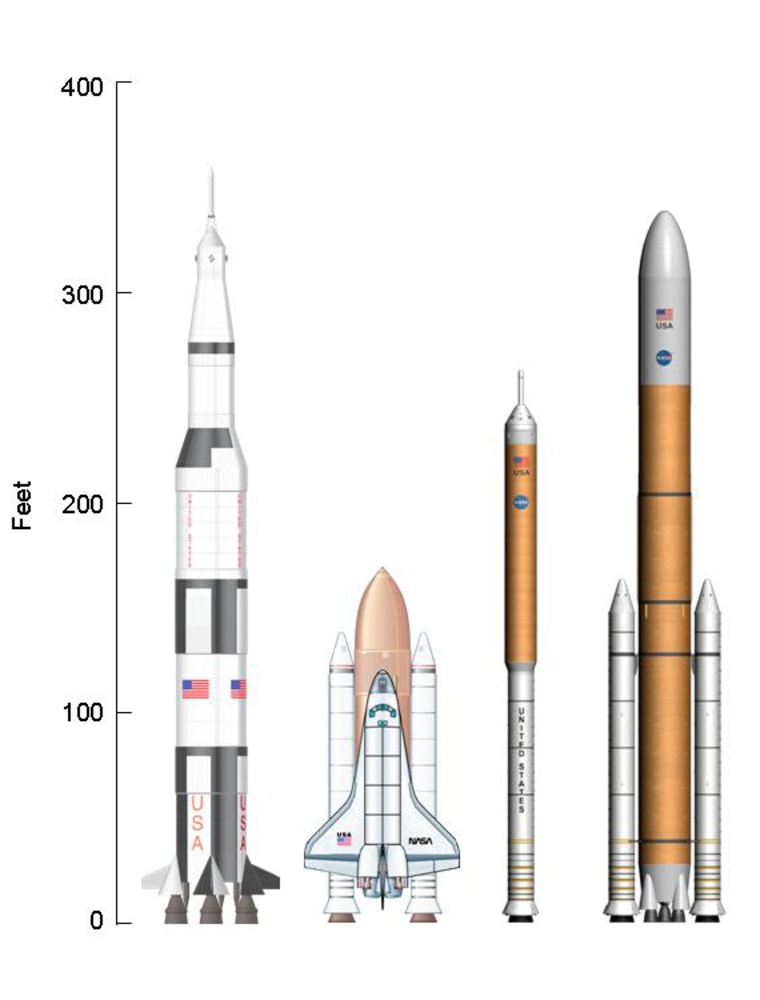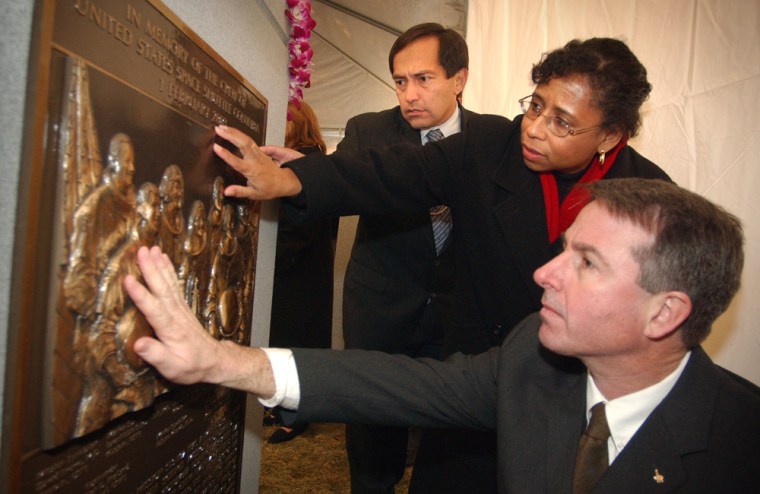After the Challenger tragedy in 1986, and again after the Columbia tragedy in 2003, presidents vowed to continue the space shuttle program as a tribute to the fallen.
But now, 20 years after the loss of the shuttle Challenger and three years after Columbia, NASA and the White House have fully accepted the view that the shuttle fleet's days are numbered, and that America's next spaceships will look nothing like the winged space planes they will replace. In fact, a decade from now, U.S. astronauts may well ride in craft that look much like the Apollo capsules of the late 1960s.
Is the shuttle program that so many people worked on for a quarter-century turning out to be a technological dead end? Will it be remembered primarily for the two disasters? What are the lessons learned for the next generation of spaceships?
Even NASA's administrator, Mike Griffin, has admitted that the space shuttle program was "not the right path" to take in the wake of the Apollo moon effort. The space agency's future approach, which he dubbed "Apollo on steroids," is aimed at correcting the mistakes made three decades ago, he said last fall.
For Scott Horowitz, the former shuttle commander who now heads up the effort to develop those future spaceships, the shuttle program nevertheless has lessons to teach.
"The shuttle program taught us how to operate on a more routine basis in space — we've flown over 100 missions on the shuttle so far," Horowitz, NASA's associate administrator for exploration systems, told MSNBC.com this week. "It also reaffirmed the lesson that going to space is difficult. This is not an endeavor without risk, so we need to learn to manage that risk. ... Taking all those lessons and rolling them into the design of the new exploration systems is probably the biggest lesson learned."
‘Big lie’?
Outside of NASA, others have been more outspoken about the shuttle system's flaws.
"Certainly there were a lot of people who deluded themselves back when they decided to pursue the shuttle," said Dwayne A. Day, a space writer and historian who served as an investigator for the Columbia Accident Investigation Board. "They believed that you could operate this thing cheap, and fast and economically. ... That was a big lie that they kept telling themselves."
After the Challenger tragedy, the shuttle's commercial and military applications were scratched, and NASA was never able to deliver on the original dream of sending a "space truck" into orbit at least twice a month. In part because of the low flight frequency, shuttle missions have been incredibly expensive, with some estimates ranging above $750 million per flight.
Despite those failings, it would be wrong to characterize the shuttle as a mistake, Day said: "Using the term 'mistake' somehow implies that they knew it was a mistake and they went ahead and tried it anyway. ... It was an attempt to push the technological frontier, and it didn't pan out."
It would also be wrong to shrug off the Challenger and Columbia tragedies as the inevitable result of taking on the risks of spaceflight, he told MSNBC.com.
"Spaceflight certainly has its risks, but if you want to look specifically at the two examples of the shuttle failures, people screwed up and ignored the clear warning signs," he said. For Challenger, those signs included excessive wear seen in the O-ring seals on the solid-rocket boosters, particularly on cold launch days. For Columbia, it was the foam debris seen falling off the shuttle's external fuel tank.
NASA is still working to fix the foam problem, with the aim of launching another shakedown mission to the international space station in May. But even if the shuttles are judged safe enough to fly again, they're due for retirement in 2010.
NBC News space analyst James Oberg noted that the shuttle won't be the first breed of flying machine to be scrapped. "After fatal disasters, sometimes aerospace systems have been abandoned — the U.S. dirigible fleet of the 1930s, for example," he said.
Changing direction
John Logsdon, director of George Washington University's Space Policy Institute and also a member of the Columbia investigation board, said the shuttle's complexity was an achievement as well as a liability.
"The shuttle is one of the most remarkable machines that humans ever built," he told MSNBC.com. "But it was too expensive and too risky. So in a sense, it said we weren't ready in 1972 — and we're not ready in 2006 — to build a vehicle that combined carrying people and carrying cargo, that had some high degree of reusability and therefore could be all things to all people."
Logsdon said NASA went with the "all things to all people" approach in the 1970s after the Nixon administration vetoed NASA's plans to set up moon bases and moving on to Mars — a grand vision much like the one that the Bush administration embraced two years ago.
Almost as soon as the first shuttle began service in 1981, NASA began planning for its replacement, said Roger Launius of the Smithsonian Institution's National Air and Space Museum, who served as NASA's chief historian for nearly 12 years. First it was the National Aerospace Plane; then it was the X-33 and X-34; then it was the Orbital Space Plane. All of them would have been reusable winged craft, but none of the concepts came to fruition.
"There are all of these projects that have been pursued since the shuttle began to fly that have not proven out," Launius observed.

The latest designs go in a different direction: Astronauts would ride in an Apollo-sized command module known as the Crew Exploration Vehicle, or CEV, which would be boosted into orbit atop a two-stage rocket with an escape tower. An unmanned heavy-lift rocket would be developed to loft payloads into space — thus delivering the components for trips to the moon, Mars and beyond.
Horowitz noted that the new vehicles would make use of upgraded versions of the shuttle's solid rocket boosters, main engines and external fuel tank, as well as a new upper stage based on the Apollo program's J-2 engines.
"We're taking the best of every program we've done and re-engineering it into the vehicles we need to do the future," Horowitz said.
The schedule for NASA's space vision calls for the shuttle fleet to go into retirement in 2010. Development of the CEV and the new rockets would begin in earnest next year, after the selection of a prime contractor, and the CEV would enter service no later than 2014. "It's our goal to do everything we can to accelerate that program," Horowitz said.
Kent Rominger, the head of NASA's Astronaut Office, said his colleagues are clamoring to be involved in the design and testing of the CEV, even though it may be eight years or more before some of them ride the craft into space. "This is the first one out of all the follow-on programs I've seen around here that we've gotten very excited about," he said.
The station and the telescope
Why not retire the fleet now, then turn full attention to the CEV? Two big tasks still have to be taken care of: finishing construction of the international space station and, if possible, making one last service call to the Hubble Space Telescope.
Observers inside and outside NASA point to Hubble servicing and station construction as two jobs only the shuttle can do.
"The importance of the shuttle is that we need it to complete the space station," Rominger said. "We believe in the space station. ... We can absolutely learn a lot from the space station and leverage the science there, particularly in the life sciences arena, and apply that to exploration to make that more efficient and safer."
The debate over whether or not the space station in its current form is worth the multibillion-dollar cost could fill a book. NASA's Griffin has said that mistakes were made in planning out the station as well as the shuttle, but NBC News space analyst James Oberg says the station would have been even less capable if it weren't for the shuttle's unmatched payload capability.
"The ability to build the station in the design it's in now rather than a 'super-Mir' is something only the shuttle could have done," Oberg observed. Whole racks of delicate experiments and bulky apparatus can be brought up by the shuttle and moved back and forth effortlessly, something that was impossible on Russia's now-extinct Mir space station.
"Things had to be placed in [Mir] like a ship in a bottle," Oberg said. "You could bring in golfbag-sized equipment and really nothing else."
Although the space station's utility will likely be debated even after the shuttles have been retired, virtually no one questions the Hubble Space Telescope's scientific value. You don't need the shuttle to put a telescope into orbit, as evidenced by the launch of the Spitzer Space Telescope in 2003. But if it weren't for the shuttle program's servicing missions, Hubble might have been written off long ago, due to the flawed optical system it had when it was launched in 1990.
"Without the shuttle, we wouldn't have Hubble," Logsdon said. "It's bound up with the shuttle first and foremost for servicing."
‘World symbol’
Looking beyond the strictly scientific realm, historians note that outer-space activities often provide a payoff in international relations as well. In the 1960s, the prime motivation behind the space effort was to show up the Russians in a Cold War race to the moon. For the past quarter-century, the shuttle has served as a similar demonstration of American technological prowess, Launius said.
"You go anywhere in the world, and people all over will recognize the shuttle as a symbol of American capability," he said. "It's been a world symbol in a way that very few other things are — and by the way, it's a positive symbol."
For all its faults, the space shuttle has been as a point of pride for Americans as well, and especially for those who took on the greatest risks: the astronauts themselves.
"Although it is risky, it is absolutely worth it," Rominger said. "As a matter of fact, there were people who had come to me as chief before Columbia happened and said, 'You know, I've flown X amount of times, and I'm going to start looking for something else.' And after Columbia, they came back in and said, 'Hey, you know what? I'm reconsidering. I want to be here for the team, so now I don't want to leave.'
"The public probably figured that it was the other way. You would think once you had the accident and people lost their lives, that the group would look around and say, 'Hmm, maybe I don't want to do that.' In fact what you saw was the opposite, and that's because we all believe in the space program and what we're doing."
